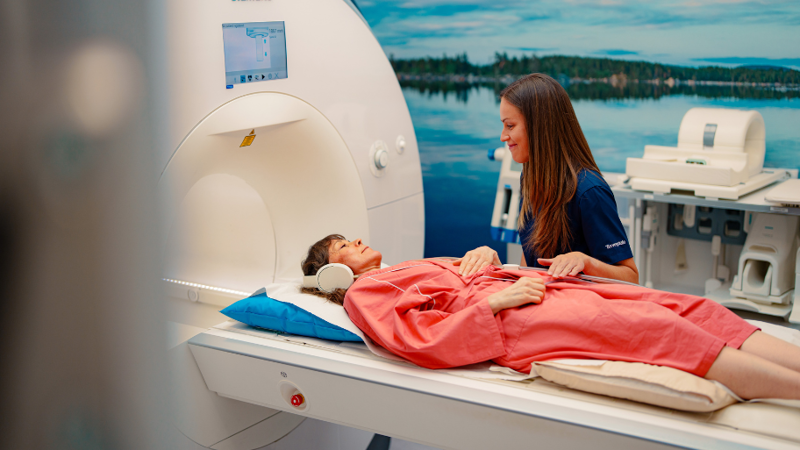A drop won't kill you, but it can tell you a lot!
To understand the big picture, you sometimes have to dive deeper than the surface. Because we can't always see the subtle signals that are key to maintaining work capacity, we need modern tools to help us find out. Nightingale's blood analysis technology, offered exclusively to Terveystalo's occupational health clients as part of a health check-up, opens a window into a person's wellbeing and potential risks to their ability to work. Antti Kangas, CTO and founder of our partner Nightingale Health, explains how a drop of blood can be used to squeeze a path to healthier and more productive work.

What can you find out from blood?
A blood sample can be used to look at metabolism, as many of the building blocks, end products and nutrients involved in different metabolic processes circulate in the bloodstream. In turn, analysing blood values can tell us where our health is heading. Based on a comprehensive blood test and analysis of the values measured, it is possible to identify the risk of developing many lifestyle diseases that threaten health and working capacity.
Metabolism and lifestyle are strongly linked and lifestyle changes, such as changing to a healthier diet, are also reflected positively in blood values and reduced risk of disease. Lifestyle choices are also linked to mental well-being. Healthy lifestyles contribute to mental well-being, while challenges to well-being make it more difficult to maintain healthy lifestyles. Lifestyle and lifestyle diseases are also strongly linked to musculoskeletal disorders. The key is to be able to identify risks early and create a virtuous circle where healthy lifestyles and overall well-being feed into each other.
How does Nightingale's blood analysis differ from a normal blood test
Traditional laboratory methods usually only analyse one or at most a few values at a time from a single blood sample. The technology developed by Nightingale can therefore be compared to magnetic resonance imaging, where a blood sample is scanned and the concentrations of many metabolic markers are measured in a single measurement. The method has been used internationally for more than 10 years in medical research and its reliability has been validated for clinical use.
Nightingale's blood analysis allows healthcare professionals to identify lifestyle-related disease risks more comprehensively and effectively than before. As a result of the blood analysis, the practitioner and the client will see a report assessing the individual risk of eight common lifestyle diseases: myocardial infarction, cardiovascular disease, type 2 diabetes, liver fibrosis and cirrhosis, alcoholic liver disease, chronic kidney disease and, in smokers, pulmonary hypertension and lung cancer.
However, the result of a blood test is not a verdict but rather an observation, as lifestyle diseases are preventable through lifestyle changes.
How quickly do values change?
Lifestyle changes can have a significant impact on the risk of disease. But changes do not happen overnight in a one-off blip. Change should be sustainable in everyday life so that it can become part of a new healthy life. This is why the recommended interval for follow-up is about 2-3 months. This is also the time it takes for blood counts to improve. The work environment and the support and incentives of the work community can also play an important role in making the change; after all, people spend a large part of their waking hours at work.
Why do we need blood analysis, isn't the Health Questionnaire enough?
There is an old saying that you can't see the wood for the trees. If a decision is based on only one thing, it is easy to make an unnecessarily one-sided interpretation. Health professionals understand this and therefore try to gather as much information as possible to make the best possible treatment decision. The health check takes a broad view of health and ability to work, allowing the use of multiple sources of information. Nightingale's blood analysis brings a new tool to the health check, based on the latest research, which will help to identify lifestyle-related disease risks more comprehensively and effectively than before. By its non-biased nature, blood analysis is a neutral way to assess health status, providing both the professional and the client with information that is not visible from the top down.
For example, BMI, which is widely used as a risk factor for health status, has excellent statistical predictive value, but it alone is not enough to make a reliable estimate. For example, a high BMI may also be the result of the body composition of people who do a lot of sport, while a person with a low BMI may be at high risk of developing a lifestyle disease.
All lifestyle diseases selected for the Health Check Risk Report have a strong metabolic component, making blood analysis an excellent way to assess their risk. The professional will also take into account other risk factors in his/her assessment, which may be identified through additional tests at the clinic (e.g. blood pressure) or through a Health Questionnaire and discussion.
How can blood analysis help predict health problems?
Unlike genetic tests, which tell us about our genetic predisposition to disease caused by hereditary factors, blood analysis can reveal things that everyone can influence through their lifestyle. Even if you are at increased risk, you may not yet have symptoms. In lifestyle diseases, there is rarely a single moment when a disease becomes symptomatic, because lifestyle diseases develop gradually. The risk report will tell you, without mincing words, where your health is heading if you keep going in the same direction. The risk report is a natural way to start a discussion to find the root causes of the risk of disease and to think together about possible changes. The aim is to ensure that the risks identified do not materialise.
Read more occupational health articles

Terveystalo's digital services have been awarded the internationally recognized ISO27001 information security certification.
Terveystalo's information security practices, processes, and risk management are in line with international best practices.

Does massage help relieve stress? – Touch restores and calms the body and mind
Stress is not always visible on the outside, but the body does show signs when the strain increases. According to Lassi Ylönen, a trained massage therapist at Terveystalo Rela, the body often communicates stress through subtle signs.

Circular economy and artificial intelligence boost performance and improve care
At the heart of sustainable healthcare, technology serves as a tool for improving both the quality of care and accountability. Terveystalo favors solutions that combine sustainability, cost-effectiveness, and medical expertise.

Psychologist: How to make Christmas a relaxed and personal celebration
For many, the anticipation of Christmas begins when cities are decked out in seasonal lights and the first chocolates, calendars, and gingerbread cookies appear on store shelves. Christmas carols ring out and the Tonttuparaati choir sings “Kiire jo on! Kiire jo on!” (Hurry up! Hurry up!). This warm and atmospheric celebration also brings other feelings to mind: how on earth can we get through all this without losing our joy and peace in the rush?

Terveystalo and Gosta Labs deepen their cooperation: the goal is to streamline work with a superior patient information system
Terveystalo is deepening its cooperation with Finnish health technology company Gosta Labs and investing €1 million in the company as a minority investor. The aim is to jointly develop artificial intelligence solutions that improve the quality of care and the efficiency of reception work as part of Terveystalo's new patient information system, Terveystalo Ella.

First aid preparedness in companies requires action and courage
First aid skills increase resilience, but a barometer survey of Finnish organizations' first aid capabilities published in October reveals that the number of trained personnel is alarmingly low.